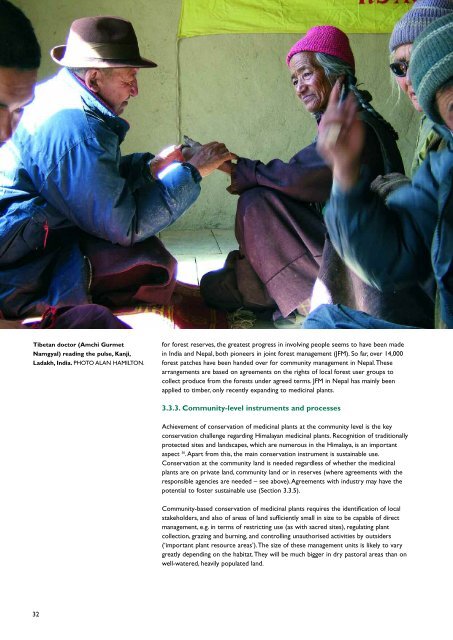<strong>Identification</strong> <strong>and</strong> <strong>Conservation</strong> <strong>of</strong> <strong>Important</strong> <strong>Plant</strong> <strong>Areas</strong> for Medicinal <strong>Plant</strong>s in the HimalayaTibetan doctor (Amchi GurmetNamgyal) reading the pulse, Kanji,Ladakh, India. PHOTO ALAN HAMILTON.for forest reserves, the greatest progress in involving people seems to have been madein India <strong>and</strong> Nepal, both pioneers in joint forest management (JFM). So far, over 14,000forest patches have been h<strong>and</strong>ed over for community management in Nepal.Thesearrangements are based on agreements on the rights <strong>of</strong> local forest user groups tocollect produce from the forests under agreed terms. JFM in Nepal has mainly beenapplied to timber, only recently exp<strong>and</strong>ing to medicinal plants.3.3.3. Community-level instruments <strong>and</strong> processesAchievement <strong>of</strong> conservation <strong>of</strong> medicinal plants at the community level is the keyconservation challenge regarding Himalayan medicinal plants. Recognition <strong>of</strong> traditionallyprotected sites <strong>and</strong> l<strong>and</strong>scapes, which are numerous in the Himalaya, is an importantaspect 50 .Apart from this, the main conservation instrument is sustainable use.<strong>Conservation</strong> at the community l<strong>and</strong> is needed regardless <strong>of</strong> whether the medicinalplants are on private l<strong>and</strong>, community l<strong>and</strong> or in reserves (where agreements with theresponsible agencies are needed – see above).Agreements with industry may have thepotential to foster sustainable use (Section 3.3.5).Community-based conservation <strong>of</strong> medicinal plants requires the identification <strong>of</strong> localstakeholders, <strong>and</strong> also <strong>of</strong> areas <strong>of</strong> l<strong>and</strong> sufficiently small in size to be capable <strong>of</strong> directmanagement, e.g. in terms <strong>of</strong> restricting use (as with sacred sites), regulating plantcollection, grazing <strong>and</strong> burning, <strong>and</strong> controlling unauthorised activities by outsiders(‘important plant resource areas’).The size <strong>of</strong> these management units is likely to varygreatly depending on the habitat.They will be much bigger in dry pastoral areas than onwell-watered, heavily populated l<strong>and</strong>.32
<strong>Identification</strong> <strong>and</strong> <strong>Conservation</strong> <strong>of</strong> <strong>Important</strong> <strong>Plant</strong> <strong>Areas</strong> for Medicinal <strong>Plant</strong>s in the HimalayaIn principle, these management areas should not be designated byscientists without community input.This is partly because the locals willgenerally know much more about their local botany than visitingscientists can discover. It is also because research has shown thatpr<strong>of</strong>essional botanists <strong>and</strong> local people have different ways <strong>of</strong> prioritizingspecies for conservation <strong>and</strong> can come up with different lists 51 . It is alsonecessarily to take into consideration the opinions <strong>of</strong> different subsectors<strong>of</strong> society (men, women; traditional doctors, commercialcollectors, etc.), each with its particular slant. Strategies for communitybasedconservation will only be successful if diverse perspectives areconsidered.Therefore, the identification <strong>of</strong> sites <strong>and</strong> species for specialattention should form a part <strong>of</strong> participatory planning withcommunities, rather than being independent scientific exercises 52 .Thesame is true for determining management arrangements.According toANSAB 21, 53, 54 , some key requirements for successful implementation <strong>of</strong>sustainable use <strong>of</strong> wild medicinal plants include: (1) clear propertyrights; (2) resource management plans that consider all communityinterests; (3) biological monitoring <strong>and</strong> information on sustainable yields(not known for most species); <strong>and</strong> (4), ideally, access to value-added processes toincrease the incentives to communities.Community-based conservation <strong>of</strong> medicinal plants is possible wherever there is asufficient local interest in these resources – whether this is for healthcare, income orculture. Currently, many Himalayan communities remain interested in medicinal plants<strong>and</strong> so there is a possibility <strong>of</strong> forming a ‘conservation grid’ across the Himalaya, foundedon community concern (a vision expressed in the National Report for India). Initiallybased on core sites, such a grid could subsequently be enlarged <strong>and</strong> strengthenedthrough the restoration <strong>of</strong> degraded intervening l<strong>and</strong>. Based on thous<strong>and</strong>s <strong>of</strong> Himalayanvillages, the grid would form a buffer for maintaining the diversity <strong>of</strong> the flora across thel<strong>and</strong>scape <strong>and</strong> for providing resilience against climatic change.Cleaning Neopicrorhiza scrophulariiflora(Pennell) Hong, Lomangthan Mustang,Central Nepal. PHOTO ARIANA WAGNER(ESON)3.3.4. Culturally related processes<strong>Conservation</strong> <strong>of</strong> plant diversity has to be based on knowledge <strong>and</strong> motivation. Religiousbeliefs <strong>of</strong>ten play a major role 50, 55 .The Menri or Medicine Mountains, part <strong>of</strong> theHengduan Mountains <strong>of</strong> Yunnan (China), are viewed as a special repository for medicinalplants for Tibetan medicine.The highest peak, Khawa Karpo, is the second most sacredmountain for Tibetan Buddhism. It is circumambulated by thous<strong>and</strong>s <strong>of</strong> pilgrims from allover Tibet each year 7 .There are numerous sacred sites on Mount Khawa Karpo, foundbetween 1900 <strong>and</strong> 4000 m.At higher elevations (4000 m) the whole area is considered asacred l<strong>and</strong>scape 50 .A statistically based study on Mount Khawa Karpo has found thatuseful species <strong>and</strong> endemic species <strong>of</strong> plants are significantly more numerous at sacredsites than elsewhere; also, that sacred sites are significantly close to villages.The highelevation parts <strong>of</strong> the mountain (the sacred l<strong>and</strong>scape) are significantly richer in endemicplant species than lower altitudes.There is no surer foundation for conservation <strong>of</strong> medicinal plants in the Himalaya thanthat provided by the exceptional knowledge <strong>and</strong> social st<strong>and</strong>ing <strong>of</strong> traditional doctors.Herbal doctors – the botanists <strong>of</strong> the Himalaya – have traditionally been concerned thatthey collect medicinal plants in sustainable ways 15, 18 . Herbal doctors can be active forplant conservation on many scales, sometimes cross-cutting communities <strong>and</strong> states.33
















